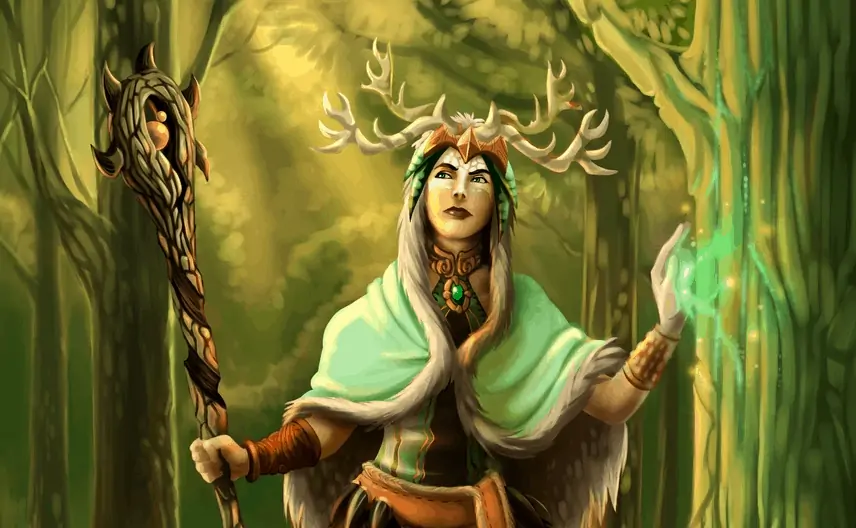Want to know how to play a Druid in Dungeons & Dragons 5th edition (D&D 5e)? Druids are the nature-loving spell-casters and staff-wielding protectors of the earth in D&D. They channel ancient natural forces for their magic and abilities and can transform into various animals.
If you want to understand the nitty-gritty mechanics of Druid spells and abilities, the Dungeons & Dragons Player’s Handbook covers all the fine print. In this guide, however, we’ll tell you everything you need to know about Druids in 5e and answer some of those niggling questions you may have. Here’s what we’ll cover in this Druid 5e guide:
- What are Druids in 5e?
- How to create a Druid
- What are Druid Circles?
- What are Druid spells in 5e?
- Frequently Asked Questions
What are Druids in 5e?
Your party is wandering through a dense and dark forest. A branch snaps nearby and suddenly eyes light up around you. Orcs have been rampaging through this ancient forest – and now they’ve found you. A hooded figure jumps into action. With a deafening crack, his staff cracks open an orc’s skull.
Suddenly he is surrounded by orcs and you fear for your companion’s life. But then you hear a roar. He has transformed into a mighty bear and begins to decimate the orcs that circle him. When the battle is over, he returns to his usual form. He approaches you and cures your wounds with a strange herbal concoction.
You might find this interesting: Comprehensive Brown Bear 5e Guide.
This is the Druid in your party. Druids in 5e are spell-casters, warriors, and healers, all determined to protect the natural world around them and the sanctity of their ancient order. As your Druid levels up, your build will determine what aspect of the class will be your strengths.
Some Druids focus on their fighting abilities, making the most of their powerful animal form, called Wild Shape, to deal damage to their foes. Other Druids use their divine spells, which are often linked to natural forces.
Druids are part of an ancient Druidic order, sometimes called the Old Faith. They revere nature and animals rather than worshipping in temples and churches.
Though Druids may meet for meetings with their Druid Circle, many Druids live the lives of hermits, avoiding contact with humanoids where possible.
Druids also hold a strong belief that the elements of the world – fire, earth, water, and air – must be kept in balance, so they are especially disturbed by elemental evil.
How to create Druid
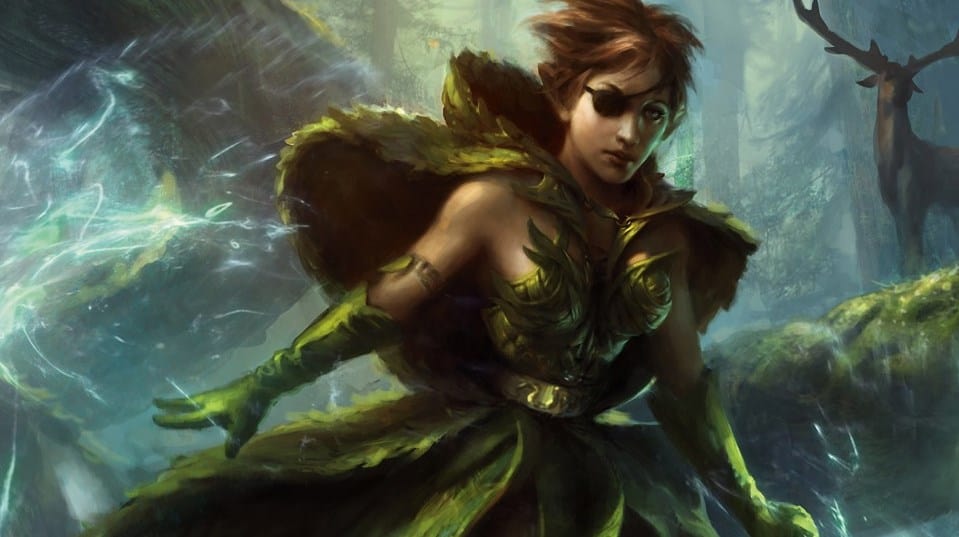
It is helpful to know what sort of Druid you would like to be when you first create your character. Is she a hermit who only emerges from the mountains when she can only use violence to protect her homeland? Is he an animal-loving elf who is a guide and healer for his party?
Figuring out your Druid’s backstory will help you make decisions throughout your campaign about your chosen abilities, spells, and Druid Circle.
Druid statistics
A Druid’s primary stat is Wisdom. This will be used for spellcasting and, along with Intelligence, your saving throws. If you want to play a Druid in 5e, having high Wisdom is a must, and a high Constitution and Intelligence also help.
Druid characteristics
- How many hit points do Druids get?
At 1st level, Druids get 8 hit points plus their Constitution modifier. From the 2nd level onwards, they get an additional 1d8 of hit points per level. - What armor can Druids wear?
Druids can wear light or medium armor and they can carry shields. Druids will not, however, wear armor or carry shields made of metal. - What weapons can Druids use?
Druids in 5e may use clubs, daggers, darts, javelins, maces, quarterstaffs, scimitars, sickles, slings, and spears. - What tools can Druids use?
Druids can use a herbalism kit – this includes clippers, a mortar and pestle, vials, and pouches, and allows the Druid to make remedies and potions.- How do herbalism kits work? Druids can do an Intelligence test to find, identify, and make remedies from herbs. If they are proficient in herbalism, Druids can add their proficiency bonus to their test. The Druid must be proficient if they want to make healing potions or antidotes.
- What saving throws are Druids proficient in?
Wisdom and Intelligence. So, if your Dungeon Master asks you to do a saving throw (such as when you’re trying to resist poison or a spell), you can add your Wisdom or Intelligence modifier to your roll. - What skills do Druids have?
When you create a Druid in 5e, you can choose two skills from the following: Arcana, Animal Handling, Insight, Medicine, Nature, Perception, Religion, and Survival. It’s worth thinking about your Druid’s background and character when you choose these. For example, a hermit Druid who has lived for years off the land driven by nothing but his faith and his survival instincts might choose Religion and Survival as his skills. - What equipment do Druids start with?
Every D&D class in 5e receives starting equipment. Druids start with: a wooden shield OR any simple weapon, a scimitar OR any simple melee weapon, leather armor, an explorer’s pack, and a druidic focus. - What languages do Druids speak?
All Druids speak Druidic, a secret language that others can only read with magic. Druids may also use this to leave secret messages, which other Druids will spot automatically.
What special abilities do Druids have?
Druids do not start with any special abilities at 1st level. As they level up, however, they gain some powerful abilities.
Wild Shape
From the 2nd level onwards, Druids can transform into an animal that they have seen before. They can do this twice in between short or long rests. Your Druid’s level will determine what sort of animal you can turn into.
At the 2nd level, for example, you can turn into an animal with a 1/4 challenge rating and no swimming or flying speed, such as a wolf. At 8th level, however, you can turn into a beast with a 1 challenge rating and no limitations, such as an eagle.
How does Wild Shape work in 5e?
Transforming into an animal comes with some rules. These include:
- Your hit dice hit points, and stats become that of the animal you have turned into. You do retain, however, your Wisdom, Charisma, and Intelligence stats.
- You cannot cast speak or cast spells (until 18th level, when you can cast many of your Druid spells)
- You remain in animal form for a number of levels equal to half your level (rounded down), until you choose to turn back, or until you are unconscious or reduced to 0 hit points.
- At the 20th level, you can use your Wild Shape ability as many times as you like.
Ability score improvement
At the 4th, 8th, 12th, 16th, and 19th levels, Druids can choose one ability score to increase by 2 or two ability scores to increase by one.
Timeless Body
From the 18th level, your body ages more slowly. For every 10 years that pass you only age 1 year.
What are Druid Circles?
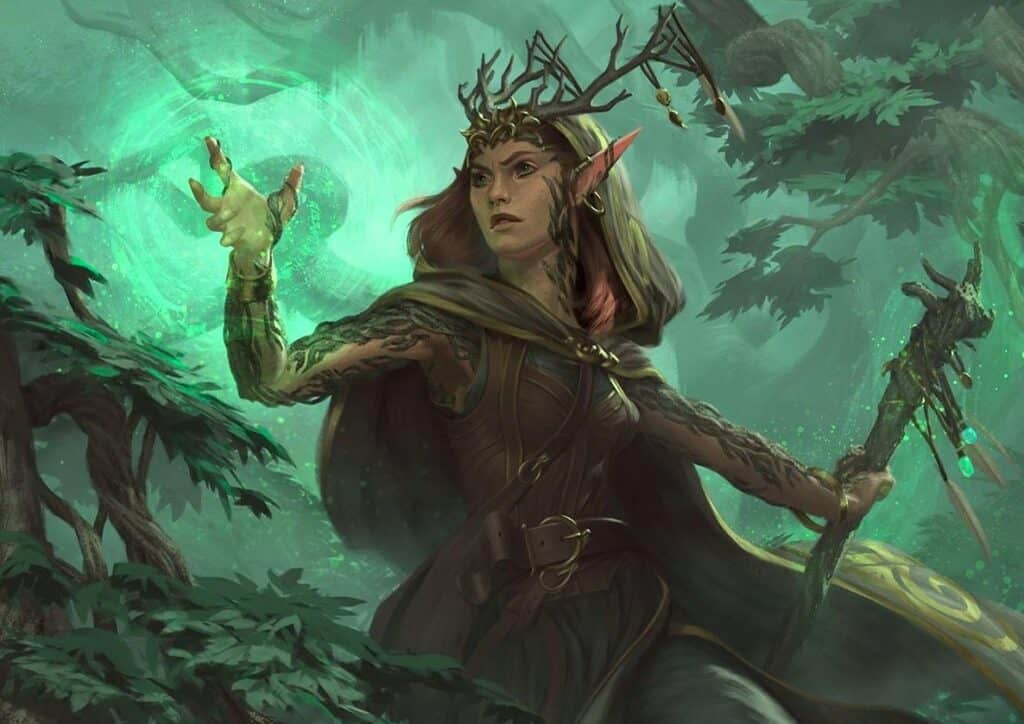
Druid Circles function as a special ability and a subclass for Druids in 5e. All Druids are part of a druidic society that either reveres the Land or the Moon. Druids in the same Circle will recognize each other and see each other as siblings.
Your Druid Circle will give you special abilities and spells at certain levels. As a Druid, you will select your Circle at the 2nd level. It is useful, however, to have an idea of what Circle you will select when creating your Druid adventurer.
Circle of the Land
The Circle of the Land is an organization of Druids who are committed to protecting and preserving the ancient knowledge of their sect. Druids in the Circle of the Land will often meet in stone circles or forests and perform ancient rites in Druidic.
Druids who choose the Circle of the Land gain several special abilities and, depending on which land they are initiated into (Mountain, Arctic, Desert etc.), also get certain spells.
What is the Circle of the Land abilities?
- Bonus Cantrip: Druids get ‘cantrips’ at 1st level, which are basic spells (see the spells section below for more details). If your Druid chooses the Circle of the Land at the 2nd level, you will get an additional cantrip of your choice.
- Natural Recovery: Druids who are part of the Circle of the Land can spend a short rest meditating outdoors to replenish spell slots. The combined level of the spell slots you regain must be no more than half your character level and they can never be 6th level or higher spell slots.
- Land’s Stride: From the 6th level, the Circle of the Land Druids do not take any extra movement to move across difficult terrain and plants and take no damage from non-magical plants (e.g. thorns).
- Nature’s Ward: From the 10th level, you are immune to poison and disease and cannot be frightened or charmed by fey.
- Nature’s Sanctuary: From the 14th level, any beast or plant creature who would attack you must pass a Wisdom saving throw first. If it fails, it will attack another target instead.
What is the Circle of the Land spells?
The land that your Druid will be part of is usually the land they became a Druid in. So if you grew up in the mountains and were initiated into the Druidic order there, you will be part of the Circle of the Mountain.
Your chosen land gives you certain spells at the 3rd, 5th, 7th, and 9th levels. Here we’ll list the lands suggested in 5e and the spells you will gain if you choose them. For full details on the Circle spells by land, see the Dungeons & Dragons Player’s Handbook.
- Arctic
3rd level: hold person, spike growth
5th level: sleet storm, slow
7th level: freedom of movement, ice storm
9th level: commune with nature, cone of cold - Coast
3rd level: mirror image, misty step
5th level: water breathing, water walk
7th level: control water, freedom of movement
9th level: conjure elemental, scrying - Desert
3rd level: blur, silence
5th level: create food and water, protection from energy
7th level: blight, hallucinatory terrain
9th level: insect plague, wall of stone - Forest
3rd level: barkskin, spider climb
5th level: call lightning, plant growth
7th level: divination, freedom of movement
9th level: commune with nature, tree stride - Grassland
3rd level: invisibility, pass without trace
5th level: daylight, haste
7th level: divination, freedom of movement
9th level: dream, insect plague - Mountain
3rd level: spider climb, spike growth
5th level: lightning bolt, meld into stone
7th level: stone shape, stoneskin
9th level: passwall, wall of stone - Swamp
3rd level: darkness, Melf’s acid arrow
5th level: water walk, stinking cloud
7th level: freedom of movement, locate creature
9th level: insect plague, scrying - Underdark
3rd level: spider climb, web
5th level: gaseous form, stinking cloud
7th level: greater invisibility, stone shape
9th level: cloudkill, insect plague
Which Circle of the Land is best in 5e?
The best all-around Circle of the Land sect is the Arctic. As an Arctic Druid, you’ll get access to a great range of Druid and non-Druid spells. If you’re planning on having your Druid stick around until 9th level and beyond, an Arctic Druid is great.
Grassland Druids getting an invisibility spell at 3rd level makes them great at a low level. If you want your Druid to be awesome in combat, playing a Mountain Druid will give them lightning bolt at 5th level, so you’ll be a formidable spellcaster relatively early.
Circle of the Moon
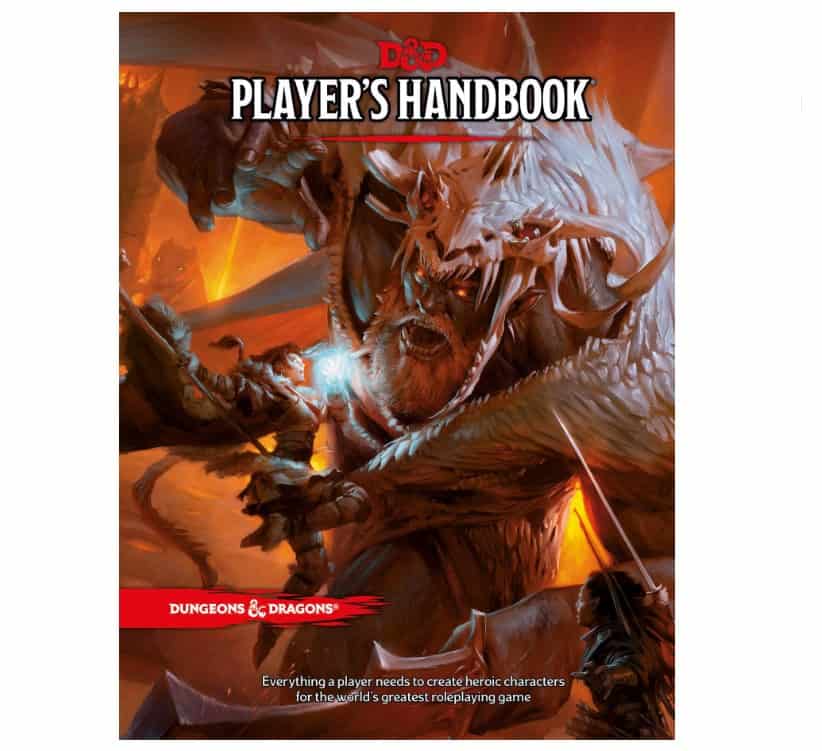
The Dungeons & Dragons Player’s Handbook describes Circle of the Moon Druids are “fierce guardians
of the wilds”.
Druids in the Circle of the Moon will meet others in their sect under the light of the moon and will spend many nights alone in the wilderness. Compared to the Circle of the Land, the Circle of the Moon Druids are much more closely connected to nature and animals, and will even eschew humanoid contact where possible.
What is the Circle of the Moon abilities?
- Combat Wild Shape: If you choose Circle of the Moon, your Druid will be able to take their Wild Shape as a bonus action rather than an action. You can also use a spell slot to regain hit points in your Wild Shape – 1d8 per level of the expended spell slot.
- Circle Forms: At the 2nd level, you can transform into a beast with a challenge rating of 1 (rather than 1/4). At the 6th level, you can turn into a creature with a challenge rating equal to your level divided by 3 (rounded down).
- Primal Strike: From the 6th level, your attacks in Wild Shape count as magical.
- Elemental Wild Shape: From the 10th level, you can use both of your Wild Shape uses to turn into an elemental – air, fire, earth, or water.
- Thousand Forms: From the 14th level, you can cast alter self at will.
What does ‘at will’ mean is 5e?: In 5e, ‘at will’ spells mean you can cast them as many times a day as you like.
What are the Druid spells in 5e?
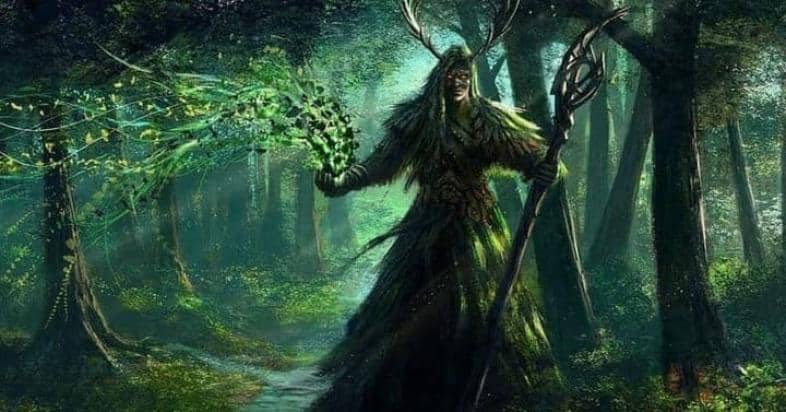
Druids have access to their own spell list in 5e and use Wisdom for their spellcasting ability. When preparing spells, Druids can choose a number of spells equal to their level plus their Wisdom modifier. You will then have a set number of spell slots depending on your level.
1st level Druids get two levels 1 spell slots. The full list and description of the Druid spells can be found in the Dungeons & Dragons Player’s Handbook. But if you’re wondering what the best level 1 Druid spells are, here are our suggestions:
- Cure wounds: A creature you touch gains 1d8 plus your spellcasting ability modifier (Wisdom modifier) worth of hit points.
- Charm person: You can charm a humanoid that you can see. So long as they fail their Wisdom saving throw, they will consider you a friendly acquaintance.
- Speak with animals: You can verbally communicate with animals for 10 minutes. Remember, not all animals will be helpful, intelligent, or friendly!
What is Druidic focus?
Druids can use the following objects (or an alternative object at the Dungeon Master’s discretion) as a spellcasting focus:
- a sprig of holly or mistletoe;
- a wand made of yew or another special wood;
- a staff made whole from a living tree;
- any object incorporating parts of sacred animals, such as bones, teeth, or feathers.
What is a spellcasting focus in 5e?: If a spellcaster wishes to cast a spell with a material (M) component, they must use either the components listed by the spell, a component pouch, OR a spellcasting focus. For example, if a Druid casts animal friendship, they will need M – a morsel of food. The Druid can either use a morsel of food or use a spellcasting focus instead.
For more information on spell components in D&D 5e, check out our post on spells.
What are cantrips?
In addition to the spells they will learn as they level up, all Druids begin with two cantrips. These spells can be cast at will and require no preparation. Your Druid will learn more of them as she levels up. The cantrips you can choose from are:
- Druidcraft: You whisper to nature and create one of the following effects:
- You create a small Effect that can predict what the weather will be for the next 24 hours;
- You can make a flower or leaf bloom;
- You can light or extinguish a candle, torch, or small campfire.
- Guidance: You touch a willing creature and for the next minute they can add 1d4 to one ability check.
- Mending: You can repair a single break or tear (no more than 1ft in its dimension) in an object that you touch
- Poison Spray: You can target a nearby creature with a puff of poisonous gas. That creature must make a Constitution test and, if they fail, take 1d12 poison damage.
- Produce Flame: A flickering flame appears in your hand. This can be used as a light or it can be hurled at enemies to deal 1d8 fire damage.
- Resistance: You touch a willing creature and for the next minute they can add 1d4 to one saving throw of their choice.
- Shillelagh: Your wooden weapon is imbued with natural power and it becomes a magical weapon. For one minute, you use your spellcasting ability instead of Strength for your hits and the weapon’s damage die becomes 1d8.
- Thorn Whip: You create a 30ft thorny whip, with which you can make a spell melee attack on a creature who, if you hit, takes 1d6 piercing damage. You can also use the whip to pull the creature closer to you.
Frequently Asked Questions
Question: Which Druid Circle should I choose?
Answer: Circle of the Moon is the easier option and will make your Druid more powerful in combat at lower levels. Circle of the Land offers more spellcasting abilities, but it is certainly a slower burn. That said, at higher levels Druids who choose the Circle of the Land will outshine Moon Druids. You could also check out some of the additional Druid Circles released in the D&D expansion, Tasha’s Cauldron of Everything.
Question: What are the best cantrips for Druids in 5e?
Answer: Whilst all the cantrips can come in handy, when you’re choosing your first two cantrips it’s worth thinking about the role your Druid will play in your party. If you want your Druid to be involved in combat and leading the party, shillelagh and produce flame are great cantrips. If you envision your Druid being a support character in combat, your party will often thank you for guidance and Druidcraft.
Question: What are the best races for Druids?
Answer: Druid’s use Wisdom above all else. Wood Elves make great Druids due to their Wisdom bonus, but you’ll miss out on Wood Elves’ proficiency in bows and swords. One of the best races to play as a Druid is a Firbolg, which first appear in Volo’s Guide to Monsters. If you play a Firbolg, your Wisdom increases by 2. Plus, these wood-dwelling half-giants perfectly fit the Druidic affinity with nature.
Question: What background should I choose for a Druid in 5e?
Answer: The Folk Hero, the Hermit, the Sage, and the Outlander are all backgrounds in 5e well-suited to Druids.
Question: Do Druids worship gods?
Answer: Many Druids worship one or more nature deity. Many regard Druidic beliefs as more ancient than the religions of Clerics and city-dwellers, and even refer to Druidic religions as the ‘Old Faith’. Your Druid may worship a deity connected to the land you choose for Circle of the Land or if you choose the Circle of the Moon, a moon deity like Selûne or a deity connected to the animal you usually transform into. There are other Druids, however, who simply worship nature itself.
Final thoughts on Druids in 5e
Druids are a fun class to roleplay and offer a lot of potential for creating a unique and compelling character. If you decide to be a Druid, you won’t be the toughest fighter or the strongest spellcaster.
But you will have a set of powerful skills that will come in handy when you least expect it! If you’re committed to playing a Druid, you or your DM should get a copy of Tasha’s Cauldron of Everything, where you’ll find a bunch of new Druid Circles and spells.
Continue reading:
- Best Alternatives to Dungeons & Dragons - August 23, 2023
- Wyverns 5e Guide: The Chickens of the Dragon Family - September 5, 2022
- Best DnD Dice Tray Ideas for Players and DMs - August 22, 2022

